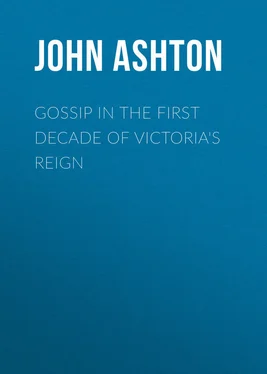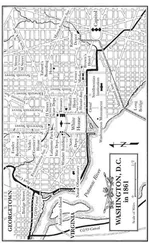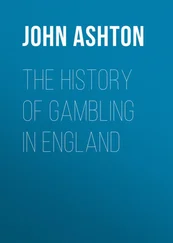John Ashton - Gossip in the First Decade of Victoria's Reign
Здесь есть возможность читать онлайн «John Ashton - Gossip in the First Decade of Victoria's Reign» — ознакомительный отрывок электронной книги совершенно бесплатно, а после прочтения отрывка купить полную версию. В некоторых случаях можно слушать аудио, скачать через торрент в формате fb2 и присутствует краткое содержание. ISBN: , Издательство: Иностранный паблик, Жанр: foreign_antique, foreign_prose, на английском языке. Описание произведения, (предисловие) а так же отзывы посетителей доступны на портале библиотеки ЛибКат.
- Название:Gossip in the First Decade of Victoria's Reign
- Автор:
- Издательство:Иностранный паблик
- Жанр:
- Год:неизвестен
- ISBN:http://www.gutenberg.org/ebooks/30665
- Рейтинг книги:3 / 5. Голосов: 1
-
Избранное:Добавить в избранное
- Отзывы:
-
Ваша оценка:
- 60
- 1
- 2
- 3
- 4
- 5
Gossip in the First Decade of Victoria's Reign: краткое содержание, описание и аннотация
Предлагаем к чтению аннотацию, описание, краткое содержание или предисловие (зависит от того, что написал сам автор книги «Gossip in the First Decade of Victoria's Reign»). Если вы не нашли необходимую информацию о книге — напишите в комментариях, мы постараемся отыскать её.
Gossip in the First Decade of Victoria's Reign — читать онлайн ознакомительный отрывок
Ниже представлен текст книги, разбитый по страницам. Система сохранения места последней прочитанной страницы, позволяет с удобством читать онлайн бесплатно книгу «Gossip in the First Decade of Victoria's Reign», без необходимости каждый раз заново искать на чём Вы остановились. Поставьте закладку, и сможете в любой момент перейти на страницу, на которой закончили чтение.
Интервал:
Закладка:
He administered a parody on the blessed Sacrament, in bread and water to his followers, before the encounter and harangued them. He told them on this occasion, as he did on many others, that there was great opposition in the land, and, indeed, throughout the world, but, that if they would follow him, he would lead them on to glory. He told them he had come to earth on a cloud, and that, on a cloud, he should some day be removed from them; that neither bullets nor weapons could injure him, or them, if they had but faith in him as their Saviour: and that if 10,000 soldiers came against them, they would either turn to their side, or fall dead at his command. At the end of his harangue, Alexander Foad, a respectable farmer, and one of his followers, knelt down at his feet and worshipped him; and so did another man named Brankford. Foad then asked Thom whether he should follow him in the body, or go home and follow him in heart. To this Thom replied: “Follow me in the body.” Foad then sprang on his feet in an ecstasy of joy, and, with a voice of great animation, exclaimed: “Oh, be joyful! Oh, be joyful! The Saviour has accepted me. Go on – go on, till I drop, I’ll follow thee!” Brankford was also accepted as a follower, and exhibited the same enthusiastic fervour, while Thom uttered terrific denunciations of eternal torture in hell fire against all who should refuse to follow him.
With the death of Thom and his deluded followers, the excitement calmed down, and entirely subsided after the trial of nine prisoners, which took place at Maidstone, on the 9th of August, before Lord Denman. They were charged on two counts: first, with aiding and abetting John Thom, alias Courtenay, in the murder of Nicholas Mears, on the 31st of May, and second, with being principals in the murder. Lord Denman charged the jury that, if they were of opinion that Thom was of unsound mind, so that, if he had been put upon his trial, he could not have been convicted of murder, the principal being acquitted, the accessories must also be acquitted, and the prisoners could not be found guilty on the first count. This, the jury acquiesced in, and brought in a verdict of “guilty” on the second count, with a strong recommendation to mercy on account of the infatuation under which they were led astray by Courtenay. Lord Denman pronounced sentence of death upon the prisoners, but added, that their lives would be spared. Two were sentenced to transportation for life; one to transportation for ten years; and the remainder to be imprisoned for one year, and kept to hard labour in the House of Correction, one month in solitary confinement.
CHAPTER VI
The Queen’s Coronation – The Carriages – The fair and festivities in Hyde Park – The Marquis of Waterford’s drive – His pranks at Melton Mowbray – Steam carriages – Dog carriages – Grand dinner at Guildhall.
The next event which occupied the public attention was the Queen’s Coronation, which took place on the 28th of June. It was, like the “Half Crownation” of William IV., a much plainer affair than that of George the Magnificent, the walking procession of all the estates of the realm, and the banquet in Westminster Hall, with all the feudal services thereunto belonging, being wholly dispensed with. The day began badly, with a cold shower about 8 a.m., but it cleared off, and the sun shone out fitfully, throughout the time the ceremony occupied – the head of the procession starting from Buckingham Palace at 10 a.m., and the Queen reaching Westminster Abbey at half-past eleven. Next to the Queen herself, the principal attraction in the procession was the equipages and liveries of the Ambassadors Extraordinary, chief among which was the carriage of Marshal Soult (who represented France), which had formerly belonged to the last great prince of the House of Condé, the father of the Duc de Bourbon, and which, by its superior magnificence, eclipsed all other vehicles. Besides which, it held the Duke of Dalmatia, Wellington’s old foe, who had now come to visit, in peace, the country he had so manfully fought against.
Of the ceremony itself, I say nothing – everything was done decorously and in order. It took a long time, for it was a quarter to four when the royal procession reformed and took its way through the nave of the abbey. The Queen entertained a party of 100 at dinner; and, in the evening, witnessed, from the roof of her palace, the fireworks discharged in the Green Park. The Duke of Wellington gave a grand ball at Apsley House, for which cards of invitation were issued for 2,000 persons.
As an indication of the numbers of people set down at the Abbey, I may mention that the carriages which were ordered to proceed (after setting down) to the south side of Westminster Bridge, occupied a line from the bridge to Kennington Cross (more than a mile). The carriages which were to proceed, after setting down their company, to the west side of London, formed a line nearly to Kensington (a mile and a half). Those ordered to wait in the Strand extended, in double lines, to St. Mary le Strand, and those directed to wait in Bird Cage Walk, St. James’s Park, occupied (in double rows) the whole line to Buckingham Palace.
There was a balloon ascent from Hyde Park, which was a comparative failure, for it descended in Marylebone Lane, quite done up with its short journey, and another sent up from Vauxhall, which was more successful. There were grand displays of fireworks in the Green and Hyde Parks, and all London was most beautifully and brilliantly illuminated.
But the great thing was the Fair in Hyde Park, which had official leave to exist for two days – but which, in fact, lasted four. The area allotted to it comprised nearly one third of the Park, extending from near the margin of the Serpentine to within a short distance of Grosvenor Gate. The best account I know of this Fair is in The Morning Chronicle of 29 June, and I here reproduce it:
“Of all the scenes which we witnessed, connected with the Coronation, probably this was the most lively, and that in which there was the least confusion, considering the mass of persons collected together. Our readers are already aware that the Fair was permitted to take place by the Government, on the petition of the present holders of the show which formerly belonged to the celebrated Richardson; and it was to their care, together with that of Mr. Mallalieu, the Superintendent of Police, that its general management was entrusted. In justice to those gentlemen, we must say that the arrangements made for the accommodation of the public were admirable, while they were carried out with the very greatest success. The booths were arranged in a square form, and covered a space of ground about 1,400 feet long and about 1,000 feet broad.
“They were arranged in regular rows, ample space being allowed between them for the free passage of the people; and they consisted of every variety of shape, while they were decked with flags of all colours and nations. One portion of the fair was set apart exclusively for ginger-bread and fancy booths, while those rows by which these were surrounded were appropriated to the use of showmen, and of persons who dealt in the more substantial articles of refreshment. Of the latter description, however, the readers would recognize many as regular frequenters of such scenes; but, probably, the booth which attracted the greatest attention, from its magnitude, was that erected by Williams, the celebrated boiled beef monger of the Old Bailey. This was pitched in the broadest part of the fair, and immediately adjoining Richardson’s show; and, at the top of it was erected a gallery for the use of those who were desirous of witnessing the fireworks in the evening, and, to which, access was to be procured by payment of a small sum.
“While this person, and the no less celebrated Alger, the proprietor of the Crown and Anchor, were astonishing the visitors with the enormous extent of the accommodation which they could afford the public, others set up claims of a character more agreeable to the age in the exceedingly tasty mode in which they had decorated their temporary houses. Of these, that which struck us as most to be admired, was a tent erected by a person named Bull, of Hackney, the interior of which, decorated with fluted pillars of glazed calico, had a really beautiful appearance. It would be useless, however, to attempt to particularize every booth, for each held out its alluring attractions to the gaping crowd with equal force, and each appeared to be sufficiently patronized by the friends of its proprietor.
Читать дальшеИнтервал:
Закладка:
Похожие книги на «Gossip in the First Decade of Victoria's Reign»
Представляем Вашему вниманию похожие книги на «Gossip in the First Decade of Victoria's Reign» списком для выбора. Мы отобрали схожую по названию и смыслу литературу в надежде предоставить читателям больше вариантов отыскать новые, интересные, ещё непрочитанные произведения.
Обсуждение, отзывы о книге «Gossip in the First Decade of Victoria's Reign» и просто собственные мнения читателей. Оставьте ваши комментарии, напишите, что Вы думаете о произведении, его смысле или главных героях. Укажите что конкретно понравилось, а что нет, и почему Вы так считаете.












